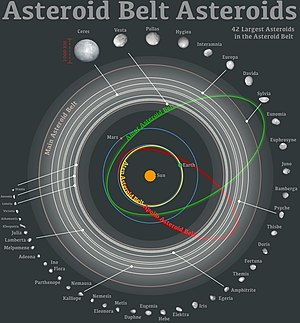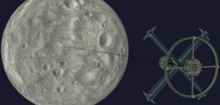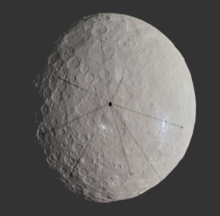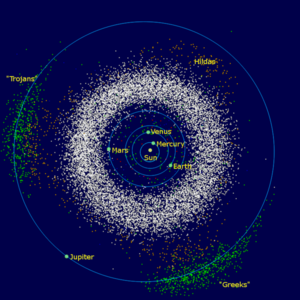
Asteroids, including those in the asteroid belt, have been suggested as possible sites of space colonization. Motives include the survival of humanity, and the specific economic opportunity for asteroid mining. Obstacles include transportation distance, temperature, radiation, lack of gravity, and psychological issues.
Most asteroids have minerals that could be mined. Because these bodies do not have substantial gravity wells, only a low delta-V is needed to haul materials to a construction site. There is estimated to be enough material in the main asteroid belt alone to build enough space habitats to equal the habitable surface area of 3,000 Earths.
Driving forces
Main article: Space and survivalOne of the primary arguments for space colonization is to ensure the long-term survival of the human species. In the event of worldwide artificial or natural disaster a space colony would allow the human species to continue on. Michael Griffin, the NASA administrator in 2006, stated the case as follows:
“... the goal isn't just scientific exploration ... it's also about extending the range of human habitat out from Earth into the solar system as we go forward in time ... In the long run a single-planet species will not survive ... If we humans want to survive for hundreds of thousands or millions of years, we must ultimately populate other planets.”
A specific argument for asteroid colonization is the potential economic gain from asteroid mining. Asteroids contain a significant amount of valuable materials, including rare minerals and precious metals, which can be mined and transported back to Earth to be sold. With approximately as much iron as the world produces in 100,000 years, 16 Psyche is one such asteroid worth approximately $10 quintillion in metallic iron and nickel. NASA is planning a mission for October 10, 2023 for the Psyche orbiter to launch and get to the asteroid by August 2029 to study. 511 Davida could have $27 quadrillion worth of minerals and resources.
NASA estimates that between 1.1 and 1.9 million asteroids in the asteroid belt are larger than 1 kilometer in diameter. Millions are smaller. Approximately 8% of known main belt asteroids are similar in composition to 16 Psyche. One company, Planetary Resources, is already aiming to develop technologies with the goal of using them to mine asteroids. Planetary Resources estimates some 30-meter long asteroids to contain as much as $25 to $50 billion worth of platinum.
Transportation
Interplanetary spaceflight is a challenge because the asteroid belt is far, hundreds of millions of miles or km away. A human mission to Mars, tens of millions of miles or km, is similarly challenging. The Mars rover mission, for example, took 253 days to get to Mars. Russia, China, and the European Space Agency ran an experiment, called MARS-500, between 2007 and 2011 to gauge the physical and psychological limitations of crewed space flight. The experiment concluded that 18 months of solitude was the limit for a crewed space mission. With current technology the journey to the asteroid belt would be greater than 18 months, suggesting that a crewed mission may require overcoming this challenge.
Landing
See also: List of minor planets and comets visited by spacecraftAsteroids are not large enough to produce significant gravity, making it difficult to land a spacecraft. Humans have yet to land a spacecraft on an asteroid in the asteroid belt, but uncrewed spacecraft have temporarily landed on a few asteroids, the first of which in 2001 was 433 Eros, a NEA from the Amor group, more recently 162173 Ryugu, another NEA of the Apollo group. This was part of the Hayabusa2 mission that was conducted by the Japanese Space Agency. The landing used four solar ionic thrusters and four reaction wheels for orientation control and orbit control of the spacecraft to land on Ryugu. These technologies may be applied to complete a successful similar landing in the asteroid belt.

Surface gravity is less than 3% of Earth's
Ceres

Ceres is a dwarf planet and the largest body in the asteroid belt. As it is cryovolcanic, it has potential for asteroid mining of resources for colonization. Its gravitational pull is stronger than other bodies in the asteroid belt, making surface colonization a more realistic possibility.
Mining the Asteroid Belt from Mars
See also: Category:Main-belt asteroids, Amor asteroids, and Apollo asteroids
| Sun Jupiter trojans Orbits of planets | Asteroid belt Hilda asteroids (Hildas) Near-Earth objects (selection) |
Since Mars is much closer to the Asteroid belt than Earth is, it would take less Delta-v to get to the Asteroid belt and return minerals to Mars. One hypothesis is that the origin of the Moons of Mars (Phobos and Deimos) are actually Asteroid captures from the Asteroid belt. Using the moon Phobos to launch spacecraft is energetically favorable and a useful location from which to dispatch missions to main belt asteroids. Mining the asteroid belt from Mars and its moons could help in the Colonization of Mars.
A space elevator based on Phobos could reduce the cost of transport. See Colonization of Mars#Transportation
Challenges for human habitation
Gravity
Lack of gravity has many adverse effects on human biology. Transitioning gravity fields has the potential to impact spatial orientation, coordination, balance, locomotion, and induce motion sickness. Asteroids, without artificial gravity, have relatively little gravity in comparison to earth. Without gravity working on the human body, bones lose minerals, and bone density decreases by 1% monthly. In comparison, the rate of bone loss for the elderly is between 1–1.5% yearly. The excretion of calcium from bones in low gravity makes higher risk of kidney stones. Additionally, fluids in the body shift towards the head, possibly causing pressure in the head and vision problems.
Overall physical fitness tends to decrease as well, and proper nutrition becomes much more important. Without gravity, muscles are engaged less and overall movement is easier. Without intentional training, muscle mass, cardiovascular conditioning and endurance will decrease.
Artificial gravity
Artificial gravity offers a solution to the adverse effects of zero gravity on the human body. One possibility, investigated in a study conducted by researchers at the University of Vienna, involves hollowing out and rotating a celestial body. Colonists would then live within the asteroid, and the centrifugal force would simulate Earth's gravity. The researchers found that while it may be unclear as to whether asteroids would be strong enough to maintain the necessary spin rate, they could not rule out such a project if the dimensions and composition of the asteroid were within acceptable levels.
Currently, there are no practical large-scale applications of artificial gravity for spaceflight or colonization efforts due to issues with size and cost. However, a variety of research labs and organizations have performed a number of tests utilizing human centrifuges to study the effects of prolonged sustained or intermittent artificial gravity on the body in an attempt to determine feasibility for future missions such as long-term spaceflight and space colonization. A research team at the University of Colorado Boulder found that they were able to make all participants in their study feel comfortable at approximately 17 revolutions per minute in a human centrifuge, without the motion sickness that tends to plague most trials of small-scale applications of artificial gravity. This offers an alternative method which may be more feasible considering the significantly reduced cost in comparison to larger structures.
Temperature
Most asteroids are located in the asteroid belt, between Mars and Jupiter. This is a cold region, with temperatures ranging from –73 °C to –103 °C. Human life will require a consistent energy source for warmth.
Radiation
In space, cosmic rays and solar flares create a lethal radiation environment. Cosmic radiation has the potential to increase risk of heart disease, cancer, central nervous system disorder, and acute radiation syndrome. On Earth, we are protected by a magnetic field and our atmosphere, but asteroids lack this defense.
One possibility for defense against this radiation is living inside of an asteroid. It is estimated that humans would be sufficiently protected from radiation by burrowing 100 meters deep inside of an asteroid. However, the composition of asteroids creates an issue for this solution. Many asteroids are loosely organized rubble piles with very little structural integrity.
Psychology
Space travel has a huge impact on human psychology, including changes to brain structure, neural interconnectivity, and behavior.
Cosmic radiation has the ability to impact the brain, and has been studied extensively on rats and mice. These studies show the animals suffer from decreases in spatial memory, neural interconnectivity, and memory. Additionally, the animals had an increase in anxiety and fear.
The isolation of space and difficulty sleeping in the environment also contribute to psychological impacts. The difficulty of speaking with those on Earth can contribute to loneliness, anxiety, and depression. A Russian study simulated the psychological impacts of extended space travel. Six healthy males from various countries but with similar educational backgrounds to astronauts lived inside an enclosed module for 520 days in 2010–11. The members of the survey reported symptoms of moderate depression, abnormal sleep cycles, insomnia, and physical exhaustion.
In addition, NASA reports that missions on the global scale have ended or been halted due to mental issues. Some of these issues include shared mental delusions, depression, and becoming distressed from failed experiments.
However, in many astronauts, space travel can actually have a positive mental impact. Many astronauts report an increase of appreciation for the planet, purpose, and spirituality. This mainly results from the view of Earth from space.
See also
- 16 Psyche
- Exploration of 16 Psyche - mission launched 2023 for 2029 arrival
- Colonization of Mars
- Asteroid mining
- Mining the Asteroid Belt from Mars
- Space colonization
- Asteroid belt
- Space habitat
- Gravity train
- Space elevator
- Orbital ring
References
- ^ Allison, Peter Ray (June 13, 2018). "How we could survive on an asteroid". BBC. Retrieved November 8, 2019.
- Pournelle, Dr. Jerrold E. (1980). A Step Farther Out. W.H. Allen. ISBN 978-0491029414.
- Space Resources Materials (PDF) (Report). NASA. 1992. p. 51. Retrieved November 21, 2022.
- "Limits to Growth", Chapter 7, Space Settlements: A Design Study. NASA, 1975.
- Kaku, Michio (2018). The future of humanity : terraforming Mars, interstellar travel, immortality, and our destiny beyond Earth (First ed.). New York. ISBN 9780385542760. OCLC 1013774445.
{{cite book}}: CS1 maint: location missing publisher (link) - "NASA's Griffin: 'Humans Will Colonize the Solar System'". September 25, 2005. Retrieved November 8, 2019.
- Parnell, Brid-Aine (May 26, 2017). "NASA Will Reach Unique Metal Asteroid Worth $10,000 Quadrillion Four Years Early". Forbes. Retrieved November 9, 2019.
- "NASA Continues Psyche Asteroid Mission". Jet Propulsion Laboratory. October 28, 2022.
- Gough, Evan (June 21, 2022). "Could We Use Mars as a Base for Asteroid Mining?". Universe Today.
- Atkinson, Nancy (September 10, 2015). "What are asteroids?". Phys.org. Retrieved November 9, 2019.
- "Asteroids: In Depth". NASA Solar System Exploration. Retrieved November 9, 2019.
- Klotz, Irene (April 24, 2012). "Tech billionaires bankroll gold rush to mine asteroids". Reuters. Retrieved November 9, 2019.
- ^ Williams, Matt (August 10, 2016). "How Long Does it Take to get to the Asteroid Belt?". Universe Today. Retrieved November 8, 2019.
- ^ mars.nasa.gov. "Mars Close Approach | Mars in our Night Sky". NASA’s Mars Exploration Program. Retrieved November 8, 2019.
- ^ "Long-duration space travel". iop.org. Archived from the original on May 2, 2019. Retrieved November 8, 2019.
- Byrd, Deborah (September 9, 2019). "What asteroid Ryugu told us". EarthSky. Retrieved November 8, 2019.
- ^ "Hayabusa 2: In Depth". NASA Solar System Exploration. Retrieved November 8, 2019.
- Calculated based on known parameters:
- Surface area: 4πr
- Surface gravity: GM/r
- Escape velocity: √2GM/r
- Rotation velocity: rotation period/circumference
- "In Depth | Ceres". NASA Solar System Exploration. Archived from the original on April 21, 2019. Retrieved April 21, 2019.
- "Potato-Shaped Mars Moon Phobos May be a Captured Asteroid". Space.com. January 15, 2014.
- Taylor, Anthony J.; McDowell, Jonathan C.; Elvis, Martin (2022). "Phobos and Mars orbit as a base for asteroid exploration and mining". Planetary and Space Science. 214: 105450. Bibcode:2022P&SS..21405450T. doi:10.1016/j.pss.2022.105450. S2CID 247275237.
- Carter, Jamie (October 19, 2021). "Space Mining: Scientists Discover Two Asteroids Whose Precious Metals Would Exceed Global Reserves". Forbes.
- Carter, Jamie (October 26, 2021). "Hubble Examines Massive Metal Asteroid Called 'Psyche' That's Worth Way More Than Our Global Economy". Forbes.
- Carter, Jamie (June 12, 2021). "NASA Heads for 'Psyche,' A Mysterious Metallic Asteroid That Could be the Heart of a Dead Planet". Forbes.
- ^ Perez, Jason (March 30, 2016). "The Human Body in Space". NASA. Retrieved November 8, 2019.
- "Ceres: By the Numbers". NASA Solar System Exploration. Retrieved November 8, 2019.
- Maindl, Thomas I.; Miksch, Roman; Loibnegger, Birgit (2019). "Stability of a Rotating Asteroid Housing a Space Station". Frontiers in Astronomy and Space Sciences. 6: 37. arXiv:1812.10436. Bibcode:2019FrASS...6...37M. doi:10.3389/fspas.2019.00037. ISSN 2296-987X.
- Feltman, Rachel (May 3, 2013). "Why Don't We Have Artificial Gravity?". Popular Mechanics. Retrieved November 8, 2019.
- Clément, Gilles (November 24, 2017). "International roadmap for artificial gravity research". npj Microgravity. 3 (1): 29. doi:10.1038/s41526-017-0034-8. ISSN 2373-8065. PMC 5701204. PMID 29184903.
- Strain, Daniel (July 2, 2019). "Artificial gravity—without the motion sickness". CU Boulder Today. Retrieved November 8, 2019.
- Williams, Matt (August 24, 2015). "What is the asteroid belt?". Phys.org. Retrieved November 8, 2019.
- ^ Globus, Al. "Space Settlement Basics". NASA. Archived from the original on November 5, 2009.
- ^ Al-Rodhan, Nayef (February 27, 2018). "This is your brain on Mars: what space travel does to our psychology". Prospect Magazine. Retrieved November 8, 2019.
- ^ Weir, Kirsten (June 2018). "Mission to Mars". Monitor on Psychology. 49 (6). American Psychological Association: 36. Retrieved November 8, 2019.
- ^ Morris, Nathaniel P. (March 14, 2017). "Mental Health in Outer Space". Scientific American Blog Network. Retrieved November 8, 2019.
- Goldhill, Olivia (September 6, 2015). "Astronauts report an "overview effect" from the awe of space travel—and you can replicate it here on Earth". Quartz. Retrieved November 8, 2019.
| Asteroids | |||||||||
|---|---|---|---|---|---|---|---|---|---|
| Main | |||||||||
| Distribution |
| ||||||||
| Classification |
| ||||||||
| Exploration | |||||||||
| Lists | |||||||||
| Related | |||||||||
| Space colonization | |
|---|---|
| Core concepts | |
| Space habitats | |
| Colonization targets | |
| Terraforming targets | |
| Organizations | |
Categories: